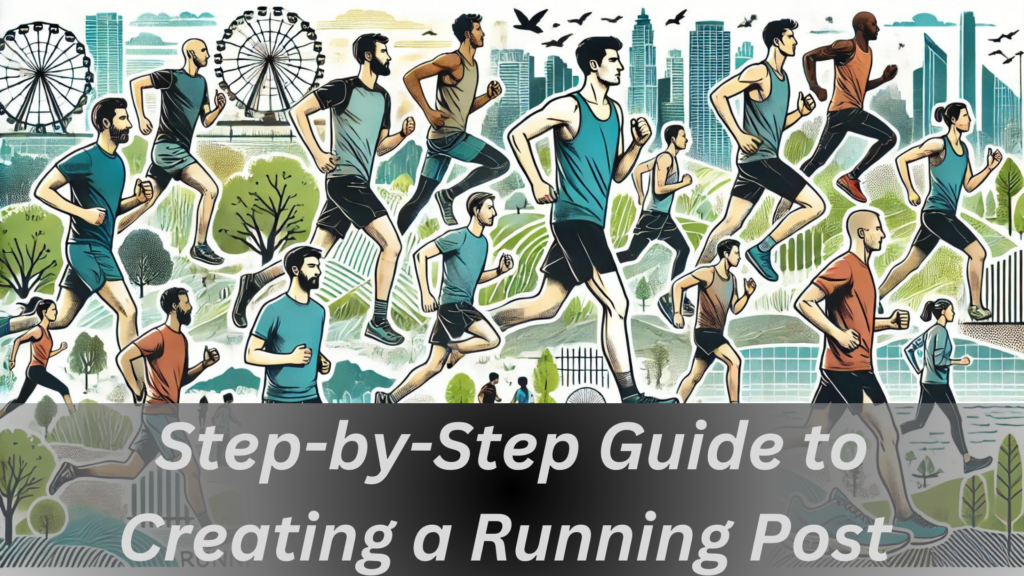
Running Post – Step By Step Detail – Dot Movie
Introduction
If you’re passionate about running or just getting started, you might have come across the term “Running Post.” This phrase can mean different things to different people, but generally, it refers to the updates, insights, and tips related to running that keep enthusiasts informed and motivated.
What is a Running Post?

A “Running Post” is a type of content focused on running-related topics. It’s a place where runners, both seasoned and beginners, can find updates, tips, and advice about running. This might include information on the latest running shoes, workout routines, race strategies, injury prevention, and recovery methods.
A Running Post can be found in various formats like blog articles, social media updates, or newsletters. Essentially, it’s a go-to resource that helps runners stay informed and motivated to improve their performance and enjoy their running journey.
Why is a Running Post Important?
Understanding the importance of a Running Post can help you see how it benefits runners of all levels. Here’s why it matters:
Keeps Runners Informed
- Latest Updates: Provides current information on trends, gear, and events.
- Expert Advice: Offers tips from experienced runners and coaches.
- Safety Information: Alerts on new findings about injury prevention and health.
Motivates and Inspires
- Success Stories: Shares achievements and journeys of other runners.
- Training Tips: Offers practical advice to help you improve.
- Challenge Ideas: Suggests new goals or challenges to keep your running routine exciting.
Enhances Performance
- Gear Recommendations: Helps you choose the best equipment for your needs.
- Workout Plans: Provides structured plans to improve your speed and endurance.
- Recovery Strategies: Advises on how to recover effectively after runs.
Builds Community
- Connection: Links you with other runners who share similar interests.
- Events: Keeps you updated on local and global running events.
- Support: Offers a platform for asking questions and sharing experiences.
Step-by-Step Guide to Creating a Running Post

Creating a compelling Running Post involves several key steps to ensure it’s informative and engaging. Here’s a straightforward guide to help you craft an effective Running Post:
Define Your Objective
- Identify Your Goal: Decide what you want to achieve with your post (e.g., share running tips, review gear, or provide race updates).
- Know Your Audience: Understand who you’re writing for—beginners, seasoned runners, or a general audience.
Choose Your Topic
- Focus Area: Select a specific topic within running (e.g., training plans, nutrition, or injury prevention).
- Research: Gather information from credible sources to ensure accuracy and relevance.
Create an Outline
- Headings and Subheadings: Organize your content with clear headings and subheadings.
- Bullet Points: Use bullet points to list important information and make it easy to read.
- Flow: Arrange the sections logically to ensure a smooth reading experience.
Write the Content
- Introduction: Start with a brief overview of what the Running Post will cover.
- Body: Develop each section according to your outline, providing detailed information and practical advice.
- Conclusion: Summarize the key points and include a call-to-action if relevant (e.g., encouraging readers to comment or share).
Edit and Proofread
- Check for Clarity: Ensure the content is clear and easy to understand.
- Correct Errors: Look for spelling, grammar, and punctuation mistakes.
- Optimize: Make sure your post includes the keyword “Running Post” appropriately.
Add Visuals
- Images: Include relevant images or infographics to enhance the content.
- Videos: Add videos if they provide additional value (e.g., exercise demonstrations or gear reviews).
Publish and Promote
- Choose a Platform: Publish your Running Post on your blog, website, or social media.
- Share: Promote your post through social media channels, newsletters, or running forums.
- Engage: Respond to comments and feedback to build a connection with your audience.
Review and Update
- Monitor Performance: Track how your post performs (e.g., views, shares, comments).
- Update Regularly: Refresh the content as needed to keep it current and relevant.
Advantages and Disadvantages of a Running Post
Understanding the pros and cons of a Running Post can help you leverage its benefits while being mindful of its limitations.
Advantages
Keeps Runners Updated
- Current Information: Provides the latest news and trends in the running world.
- Timely Tips: Offers up-to-date advice and recommendations.
Enhances Motivation
- Inspirational Stories: Shares success stories and experiences that encourage readers.
- Goal Setting: Helps runners set and achieve new goals with practical advice.
Offers Practical Advice
- Running Post:Provides structured workout plans to improve performance.
- Gear Reviews: Offers insights into the best running gear and equipment.
Builds a Community
- Engagement: Connects runners through shared interests and discussions.
- Support: Creates a platform for asking questions and getting support from fellow runners.
Educates on Safety and Health
- Injury Prevention: Provides information on how to avoid and manage running-related injuries.
- Recovery Tips: Offers strategies for effective recovery and overall health.
Disadvantages
Information Overload
- Too Much Content: With so many posts available, it can be overwhelming to find valuable information.
- Inconsistent Quality: Not all posts are created equally; some may lack accuracy or depth.
Limited Personalization
- General Advice: Posts may provide general advice that may not apply to every individual’s needs.
- One-Size-Fits-All: Recommendations might not suit specific training goals or conditions.
Potential Bias
- Product Reviews: Some reviews may be influenced by sponsorships or advertisements.
- Subjective Opinions: Personal opinions may skew the objectivity of the information presented.
Time Consumption
- Reading Time: Keeping up with multiple posts can be time-consuming.
- Update Frequency: Posts may become outdated if not regularly updated.
Engagement Challenges
- Limited Interaction: Posts may not always offer interactive elements to engage readers deeply.
- Lack of Personal Connection: Written content may lack the personal touch of direct interaction.
What is a Running Post?
A Running Post is a piece of content focused on topics related to running. It can include tips, updates, gear reviews, training advice, and more. It’s meant to keep runners informed and motivated.
Why should I read Running Posts?
Running Posts offer valuable information that can help improve your running experience. They provide updates on new gear, training tips, motivational stories, and safety advice.
How can Running Posts help me improve my running?
Running Posts can help by:
Offering structured training plans.
Providing tips on technique and recovery.
Sharing reviews on gear to help you choose the best equipment.
Where can I find Running Posts?
You can find Running Posts on various platforms, including:
Running blogs and websites.
Social media channels.
Newsletters from running clubs or gear companies.
Are Running Posts reliable?
Most Running Posts are created by knowledgeable authors or experts. However, it’s always good to cross-check information and consult multiple sources to ensure accuracy.
Can I contribute to a Running Post?
Yes, many platforms welcome guest contributions or user-generated content. Check the guidelines of the specific blog or website if you’re interested in sharing your own running experiences or tips.
How often should I read Running Posts?
It depends on your needs and interests. Some runners read them daily for the latest updates, while others may check in weekly or monthly for new tips and advice.
Can Running Posts help me with injury prevention?
Yes, many Running Posts include information on how to prevent injuries, such as proper warm-ups, stretches, and recovery techniques. They can be a helpful resource for maintaining your running health.
What if I don’t agree with the advice in a Running Post?
Everyone’s running experience is unique. If you disagree with a post, consider looking for additional sources or consulting with a running coach to find advice that suits your needs.
How do I stay updated with new Running Posts?
You can stay updated by:
Subscribing to running blogs or newsletters.
Following running-related social media accounts.
Joining running forums or online communities.
Conclusion
A Running Post is a great resource for anyone interested in running. It keeps you updated with the latest tips, gear reviews, and training advice. By regularly checking Running Posts, you can stay motivated, learn new techniques, and connect with the running community. Whether you’re a beginner or a seasoned runner, these posts can help you reach your running goals and enjoy the journey. Happy running!
Bonus Points for Your Running Post
Include Personal Stories
- Relatable Experiences: Share your own running experiences or those of others to make your post more engaging and relatable.
- Lessons Learned: Highlight personal challenges and successes to inspire your readers.
Feature Expert Interviews
- Pro Insights: Include interviews with running coaches, athletes, or experts to provide authoritative advice and unique perspectives.
- Tips from the Top: Share valuable tips and strategies from those with extensive experience in the running world.
Add Interactive Elements
- Quizzes: Create quizzes to help readers assess their running knowledge or find their ideal training plan.
- Polls: Use polls to gather opinions or preferences from your readers on running-related topics.
Provide Additional Resources
- Links: Include links to useful resources, such as running apps, gear reviews, or training programs.
- Downloads: Offer downloadable content, like training schedules or checklists, to add extra value.
Encourage Reader Engagement
- Comments: Prompt readers to share their own running tips or experiences in the comments section.
- Social Media: Invite readers to follow your social media accounts for more updates and community interaction.
Highlight Recent Trends
- New Innovations: Feature the latest trends in running gear, technology, or techniques.
- Event Updates: Keep readers informed about upcoming running events or races.
